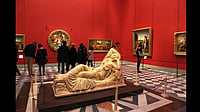Acoustics and sounds are integral to the Mandu experience. In palaces and pavilions such as the Baz Bahadur's Palace, the Rani Rupmati Pavilion and Jahaz Mahal, every brick and stone seems to carry echoes and tales of the past—in many cases, different versions of stories and folklore featuring the same characters.
Mandu’s most endearing legend is the love story between Baz Bahadur, ostensibly the Malwa region’s last independent sultan, and Rupmati, who has been variously identified as a princess as well as a shepherdess. To experience the story first-hand, I headed to the Rani Rupmati Pavilion (rather, Palace) along with our guide, Raju-ji, and four others in the afternoon of December 30, 2021, along tumbledown roads that seem to be as old as the monuments themselves. The palatial structure is situated on a hilltop overlooking the massive, picturesque Narmada valley. With a large water tank, it was probably built as a soldier outpost, ages before Baz Bahadur’s reign, but Baz Bahadur repurposed it for his beloved as a double-pavilioned retreat. From the pavilions, Rupmati must have had a spectacular view of the expansive valley and the river Narmada flowing beyond it, on a very lear day, as well as of Baz Bahadur’s palace located downhill. Legend has it that Rupmati never started her day’s duties without a glimpse of the Narmada, and Baz Bahadur built the palace for that very purpose sometime in the 16th century.


There are different versions to the story of how Rupmati and Baz Bahadur’s liaison ended tragically. One tale attributes Baz Bahadur’s fall to Adham Khan, a general of Akbar, who lusted after Rupmati and invaded Mandu to win her favour. On hearing of Mandu’s defeat, Rupmati consumed poison and threw herself into a fire. Our guide, Raju, however, was of the belief that Baz Bahadur was actually a chieftain of Akbar who had a falling out with the emperor and was killed as a result. Be that as it may, the stories all seem to agree that Baz Bahadur and Rupmati became fed up with wars and conflicts; their love bloomed out of their mutual admiration of music and songs. With its excellent acoustics still intact, it’s not surprising that Rani Rupmati Pavilion happened to be the venue of singing contests between Rupmati and Baz Bahadur back then. One wonders, however, how this interfaith love story would have worked out in the 21st century.

With the echoes of Rupmati Pavilion still ringing in our ears, we made our way to Baz Bahadur's Palace, a residence that would have surely fulfilled many functions. In its heyday, Baz Bahadur would have hosted and accommodated many of his royal guests in the interconnected corridors and halls. The palace also boasts of a jharokha from which the sultan addressed his subjects gathered below. Above all, the strategic importance of the palace must have been immense. From its windows, singular domed structures can be seen in the countryside. These structures would have been the spaces where drums were beaten in specific rhythms and sequences to convey important messages, especially those warning of an impending attack from other forces. The sounds of the message would be amplified throughout the palace, due to the special characteristics of the domes and pillars, to make evacuation easier. The inside of the domes in the palace are designed with flattened-out, lotus-patterned depressions at their base. These floral patterns are connected to the ones in the adjoining dome, and so on, throughout the length and breadth of the corridors. The result is an amplified, hollowed-out, boom-like sound that reverberates throughout the many corridors and halls in the palace—which Raju demonstrated by singing a most melodious song from across one of the corridors. This architectural style can also be seen in Rupmati Pavilion.

The next day, we encountered a different tract of history as we made our way to the Jahaz Mahal complex, where echoes of more colourful stories awaited us. Our guide for the day, Navin Lodha, regaled us with scarcely-believable stories of Ghiyas ud-Din Khalji’s feats.
Jahaz Mahal was so named because during monsoon, it resembles a ship afloat between two enormous artificial lakes at full capacity. The mahal was built as a harem for the allegedly 15,000 women (a figure that can be traced back, possibly, to the Jahangirnama) in Khalji’s seraglio. Khalji, who also bestowed the name of Shadiabad (City of Joy) upon Mandu, seems to have been an advocate of women empowerment, educating them according to their talents and aptitude, and reserving positions for them in the royal court. 1,000 women are believed to have served as his bodyguards—500 of them excelling in archery, the rest equipped with swords, shields and firearms. Ghiyas ud-Din Khalji’s insistence on providing a training in the physical arts—warfare and wrestling included—probably explains why the climb to Jahaz Mahal was somewhat arduous, and featured stairs nearly a foot or more long and wide—stairs that were supposed to provide sufficient training to Khalji’s women.

The sprawling Jahaz Mahal complex also has a massive lake that once used to be filled with camphor (hence the name, Kapoor Talao). “Here, the women of the harem would bathe and swim to a platform in the middle to rest and dry up—thus, taking care of both their beauty and their daily quota of exercise,” Navin put in. The camphor-laden water would be pumped into the fountains in the open courtyard and up the pipes on the palace walls all the way to the roof where intricate and beautifully-designed channels on the roof’s floor led the water into a pool-shaped reservoir. This was achieved through the use of an intricate system featuring gates, locks and weights. There were also provisions for rainwater harvesting and conservation, and one can still see the ruins of the large water filtration and supply plant from Jahaz Mahal’s roof. Truth be told, to a newcomer like me, it all seemed quite ahead of its time.

Diagonally opposite to the Jahaz Mahal is the Taveli Mahal. Today, it houses an archeological museum on the ground floor and a rest house and a verandah on the top floor, but in Ghiyas ud-Din’s time, it served as a tabela (horse stable), from which soldiers rode out on horses along the parapet of the fort complex to relay messages back and forth. Each floor consists of three rooms, all of which have arcades to the north. The rest house on the top floor once accommodated Jawaharlal Nehru, where a plaque commemorates the momentous visit. From Jahaz Mahal, one can also spot the ogee arches of the Hindola Mahal, which dates back to the reign of Hoshang Shah in the 15th century. In its heyday, it ostensibly served as a royal durbar.


Like Rupmati Pavilion and Baz Bahadur's Palace, Jahaz Mahal also features superb acoustics, thanks to the same architectural features seen in the former two places. The distinctive feature here is that if you shout loud enough, the echo of the phrase uttered last is heard the loudest and with the greatest clarity. At Hoshang Shah’s Tomb, which we visited next, Navin treated us to the cavernous nature of the mausoleum with a shout that boomed across the domed ceiling and walls. Members of Hoshang Shah’s family (the sultan included) are buried in six crypts here. Shah Jahan is said to have sent four of his best architects to study the magnificent white sandstone tomb as a template for the Taj Mahal.

Closely linked to Hoshang Shah’s life is another majestic monument—the Jami Masjid, one of the largest mosques in the Indian subcontinent, lying adjacent to Hoshang Shah’s Tomb. Completed during the reign of Sultan Mahmud, one of Hoshang Shah’s successors, it was initially conceived as a space where court orders would be read out from a pulpit. Curtains would be strung across beautiful intricately and exquisitely carved columns, from behind which women could hear the judgements dished out, quite audibly, due to the domes amplifying the sounds. They could also make their suggestions and comments from behind the purdahs if they felt there was injustice or a miscarriage was being carried out. Gradually, though, the space began to be used as a dharamshala, providing food and shelter to pilgrims, the poor and the needy. In its final form, the Jami Masjid became a space where people simply gathered or milled around—hence the name Jami (or Jama, as one prefers).


Right across the road, opposite the Jami Masjid complex, we took a quick tour of the Victory Tower. This site also houses Mandu’s Ashrafi Mahal, which is actually a misnomer because it was built as a madrasa to educate Sultan Mahmud’s many children. Here, Navin mentioned another anecdote (or rather, a seemingly tall story) that explained its name. When Jahangir brought a pregnant Nur Jahan to Mandu sometime in the 17th century, they stayed here. Sir Thomas Roe, who accompanied both of them, apparently suggested some light exercise for Nur Jahan during the stay—walking, but no running, jogging or hopping. As an incentive, a gold coin (ashrafi) was placed on each of the foot-long stairs (echoing or similar to the ones seen at Jahaz Mahal) everyday, so that the empress would have to pause to pick up the coins with the result that the exercise didn’t become too laborious. The coins would then be distributed to the destitute. This flight of stairs leads up to a mausoleum made of white marble (with some sections having a decorative yellow glaze) that would have once served as an entrance or pavilion to the Victory Tower lying behind it.

If there’s a monument that impresses upon one the scale of ruins in Mandu, it is the Victory Tower. Looking at this single-storey, 10 metre long ruin, one would be hard-pressed to gauge the fact that this monumental tower originally had seven storeys and was built to commemorate Mahmud Shah Khalji’s eventual victory over King Kumbha of Mewar. The reasons for its destruction still remain unknown.

Architecturally speaking, the monuments we visited show a mix of predominantly Islamic influences from Afghanistan and Iran, along with significant elements from Mughal architecture. In many ways, it’s a hodge-podge of styles that somehow merge to create things of beauty. For instance, you are likely to find keystone arches, false arches and complete ones, along with beam-and-lintel columns all in the same structure (Baz Bahadur Palace, in this case). However, one also finds stamps of Hindu architecture and symbolism in the oddest places—for example, Hoshang Shah’s Tomb has small depictions and outlines of temple spires on its walls and doorways.
Besides, Mandu is home to some Hindu and Jain temples that see significant footfall. The temple we visited was the Chaturbhuj Shree Ram Mandir that is the abode of the chaturbhuj (four-limbed) avatar of Lord Rama. According to local folklore, the four-limbed statue was hidden underground to prevent its destruction when Islamic and Mughal rulers set foot on Mandu. It reemerged long after the end of those eras. Over the course of two days, it was fascinating to see how Mandu, despite its long history of invasions, is still able to retain influences from the cultures and architectures of Muslims, Hindus, Jains and Buddhists (in the nearby Lohani Caves, that was once the home of Buddhist monks), however minute they may be. In many ways, Mandu provided a welcome retreat from the communally charged atmosphere one is continuously exposed to, these days.

As I greeted the New Year warming myself by the side of a bonfire at the glamping site of the Mandu Festival 2022, the echoes of all the stories I had heard and the historical phantoms I had encountered in the tales and the hallowed halls of the monuments seemed to appear and float past me. It was akin to experiencing the ghosts from A Christmas Carol, but the feelings I had were far more peaceful and hopeful. At that moment, Mandu seemed to fill me up with renewed vigour and hope for a better future—not just for myself but for the country as well, if only we learn the right lessons from our shared, interconnected past.

























